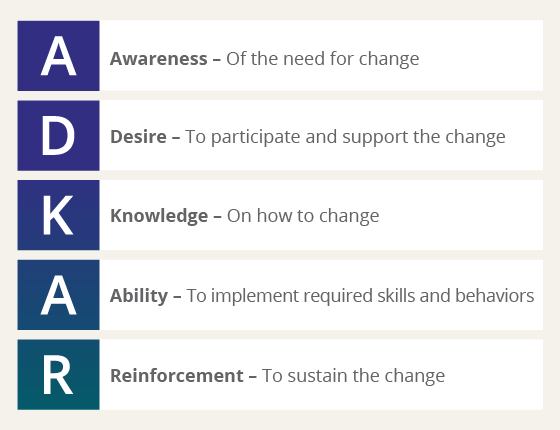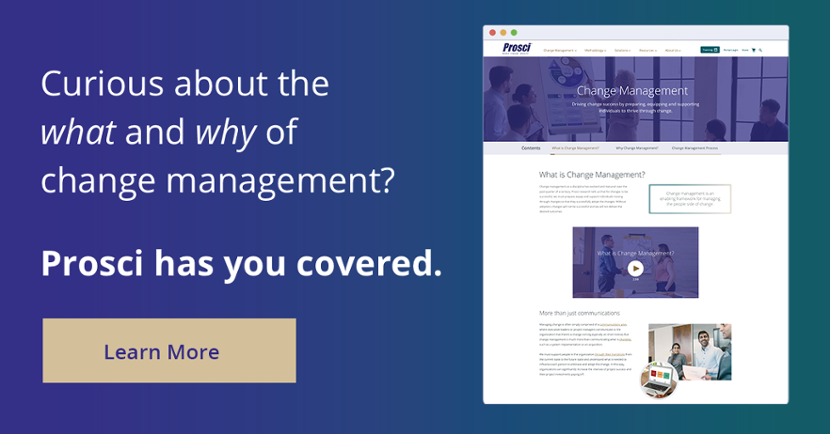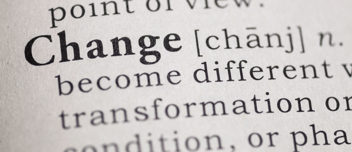Individuals Are the Epicenter of Success

4 Mins
Updated: August 5, 2024
Published: January 5, 2022

By focusing on the individuals impacted by a project or initiative, change management helps us to define change at the right level, and drive the adoption and usage necessary for projects to deliver results and outcomes. To achieve this focus, a shift from "process centering" to "individual centering" is necessary.
During the 1990s, organizations were swept up by process centering or rethinking their operations from the perspective of business processes instead of departments, functions or organizational hierarchy. As organizations have grown and evolved, and decision making and ownership have been pushed farther out in the organization, it is time for another shift.
Change is the new norm—no one expects the rate or amount of change to decrease in coming years. For organizational change to be successful, individual employees impacted by the change must make their own successful transitions. Each must engage, adopt and use the change in their processes, systems, behaviors and jobs. Instead of process centering, we must focus on individual centering of change in organizations—a task that effective change management directly supports.
The Individual Is the Unit of Change
We often think about change and change management from an organizational perspective, e.g., installing an enterprise resource planning (ERP) application, re-orienting a sales team by vertical industry instead of region, or implementing electronic medical records in a hospital. This is change from the perspective of projects and initiatives.
However, an organizational change ultimately impacts how people do their jobs every day. Individuals must enter data into the new system, engage clients in a new way, or maintain patient records with the new software. The individual is the unit of change.
Organizational change is like a mutual fund. Although it is easier and more convenient to think at the mutual-fund level, a mutual fund doesn't actually perform. The performance of a mutual fund depends on the performance of each of the stocks that make up the mutual fund. Organizational changes alone do not perform—their performance depends on the success of each individual, who must follow new processes, use new tools, or exhibit new behaviors.
Let's take a look at how Prosci's approach to change management addresses impacted individuals, or those who have to change how they do their jobs when an organization implements a project or initiative.
Impacted Individuals and Prosci’s 5 Tenets
Prosci introduced the 5 Tenets of Change Management a decade ago, and they remain valid today. Together, the tenets offer a framework for introducing, defining and positioning change management within the context of the expected results of a change:
- We change for a reason
- Organizational change requires individual change
- Organizational outcomes are the collective result of individual change
- Change management is an enabling framework for managing the people side of change
- We apply change management to realize the benefits and desired outcomes of change
Tenets 2 and 3 address the impacted individual directly. Tenet 2 says, "Organizational change requires individual change." This means that when an organization implements a project or initiative, particular people will have to do their jobs differently. Sometimes it's a few employees, sometimes it's many. Sometimes the change is not that dramatic, other times it's very dramatic. In any case, organizational change requires individual change.
Tenet 3 says, "Organizational outcomes are the collective result of individual change." This means that we only realize benefits and achieve results when employees engage, adopt and use the change. If employees do not make their own personal transitions successfully or make them slower than expected, project outcomes are compromised.
These two tenets help to set the stage for change management as the solution to support the individual transitions caused by an organizational change.
Impacted Individuals and the ADKAR Model
The Prosci ADKAR Model describes the five building blocks of successful change as:
 When a person experiences a change, whether at home or at work, they begin the change process with an answer to "Why change?" (Awareness), followed by the personal decision to make the change (Desire). Next, the person needs to know how to change (Knowledge) and demonstrate the capability to make the change (Ability). Once the change has happened, a person can slip back to the old way of doing things, unless we take intentional actions to make the change stick (Reinforcement).
When a person experiences a change, whether at home or at work, they begin the change process with an answer to "Why change?" (Awareness), followed by the personal decision to make the change (Desire). Next, the person needs to know how to change (Knowledge) and demonstrate the capability to make the change (Ability). Once the change has happened, a person can slip back to the old way of doing things, unless we take intentional actions to make the change stick (Reinforcement).
In the context of individual centering, the ADKAR Model gives us direction for supporting each of the individuals impacted by the change.
Impacted Individuals and the Prosci 3-Phase Process
Although change ultimately happens at the individual level, there are actions that a project team or change management team can take to support those changes. Prosci calls this "organizational change management" and has a research-based process for developing the strategies and plans for applying change management to a project.
The Prosci 3-Phase Process provides the guidance and tools for applying change management at the project or initiative level. The notion of "impacted individuals" comes through in each of the three phases of the process.
 Phase 1 – Prepare Approach
Phase 1 – Prepare Approach
During this initial phase, practitioners prepare the change management approach to be applied across three stages:
- Define Success – What are we trying to achieve?
- Define Impact – Who has to do their jobs differently and how?
- Define Approach – What will it take to achieve success?
We consider impacted individuals throughout Phase 1 – Prepare Approach, with activities such as connecting and aligning people to success, and looking closely at the impacts the change will have on people and groups. We also anticipate resistance to change and develop tactics to address it.

Phase 2 – Manage Change
During this phase, practitioners develop specific plans to move impacted individuals and the organization through their ADKAR transitions, and learn how to measure, track and adapt performance:
- Plan and Act – What will we do to prepare, equip and support people?
- Track Performance – How are we doing?
- Adapt Actions – What adjustments do we need to make?
Preparing, equipping and supporting impacted individuals is a key focus of this entire phase. For example, we address impacted individuals when creating change management plans, enabling managers and sponsors for their unique roles in change, and when tracking ADKAR outcomes.

Phase 3 – Sustain Outcomes
In this final phase of the Prosci 3-Phase Process, the organization achieves the project’s benefits and focuses on sustaining the outcomes. Key activities take place in three stages:
- Review Performance – Now, where are we? Are we done yet?
- Activate Sustainment – What is needed to ensure the change sticks?
- Transfer Ownership – Who will assume ownership and sustain the outcomes?
The purpose of this phase is to reach desired outcomes by ensuring that individuals are supported and equipped to adopt changes over time. For example, we consider impacted individuals when reviewing ADKAR outcomes, deciding who to gather feedback from, and identifying whose compliance we audit.
Organizational change management gives us the actions, steps and activities we take as change practitioners, but each can only be effective if the individual employees impacted by the change guide our work.
The Centerpiece of Change Management ROI
The final aspect of impacted individuals shows up in measurement. Although the Prosci CMROI Model does provide tools for calculating a return on investment for change management, it is really more about shifting the conversation about the ROI of change management.
Instead of asking, "What is the ROI of change management?" we ask, "How much of a project's benefits depend on employee adoption and usage?" When we focus on impacted individuals and their contribution to overall project benefits and results, we can begin discussing the impact of change management (and individual change) within the context of project results and outcomes.
Individuals and Successful Change
It is easy to forget the individual in times of change. We think about our goal as implementing a new system or creating a communication plan. However, for organizational change to be successful, individual employees must make a successful personal transition and adopt a new way of doing their jobs. Change management provides the focus and solution for "individual centering" change, resulting in more successful change and organizational outcomes.



